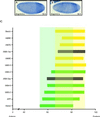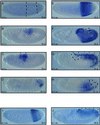Characterization of the intergenic RNA profile at abdominal-A and Abdominal-B in the Drosophila bithorax complex
- PMID: 12481037
- PMCID: PMC139232
- DOI: 10.1073/pnas.222671299
Characterization of the intergenic RNA profile at abdominal-A and Abdominal-B in the Drosophila bithorax complex
Abstract
The correct spatial expression of two Drosophila bithorax complex (BX-C) genes, abdominal-A (abdA) and Abdominal-B (AbdB), is dependent on the 100-kb intergenic infraabdominal (iab) region. The iab region is known to contain a number of different domains (iab2 through iab8) that harbor cis-regulatory elements responsible for directing expression of abdA and AbdB in the second through eighth abdominal segments. Here, we use in situ hybridization to perform high-resolution mapping of the transcriptional activity in the iab control regions. We show that transcription of the control regions themselves is abundant and precedes activation of the abdA and AbdB genes. As with the homeotic genes of the BX-C, the transcription patterns of the RNAs from the iab control regions demonstrate colinearity with the sequence of the iab regions along the chromosome and the domains in the embryo under the control of the specific iab regions. These observations suggest that the intergenic RNAs may play a role in initiating cis regulation at the BX-C early in development.
Figures




References
Publication types
MeSH terms
Substances
Grants and funding
LinkOut - more resources
Full Text Sources
Molecular Biology Databases
Research Materials

